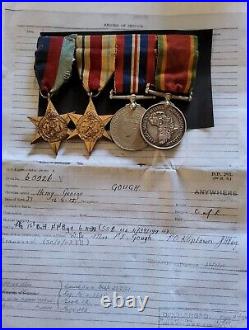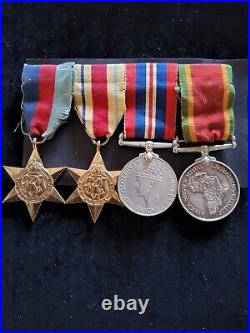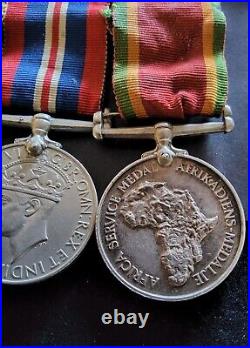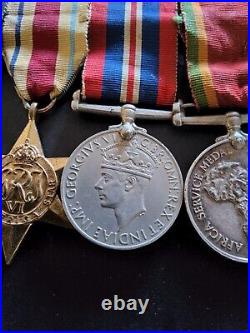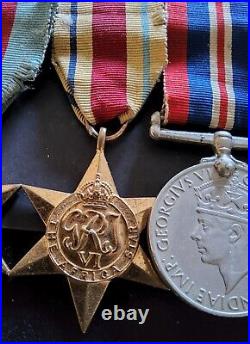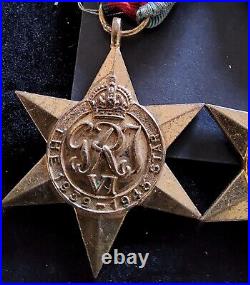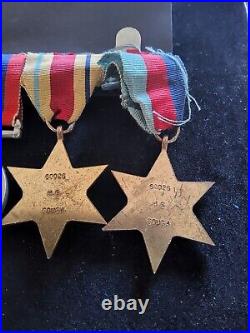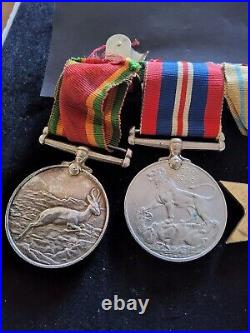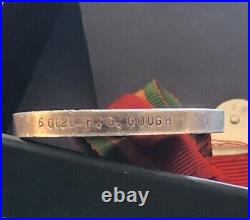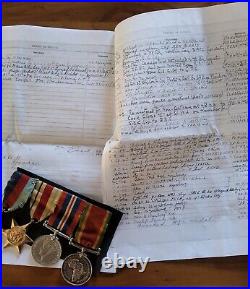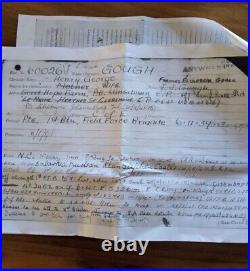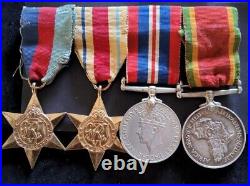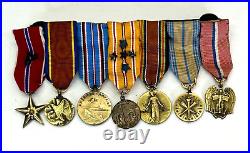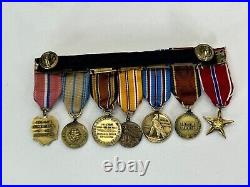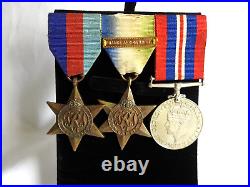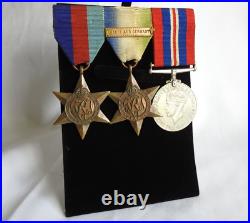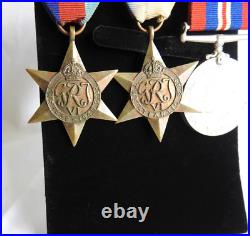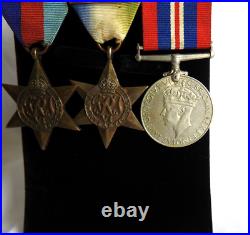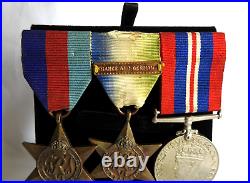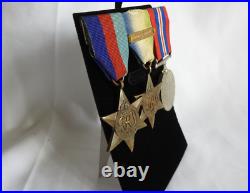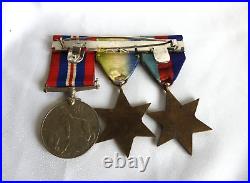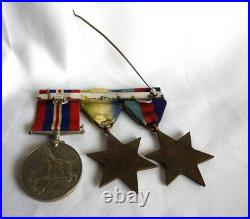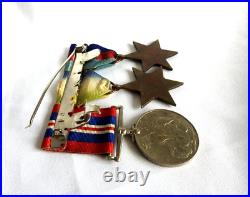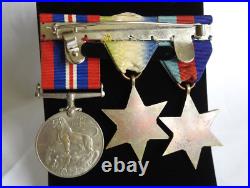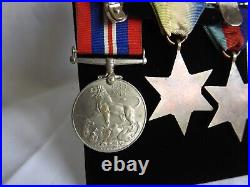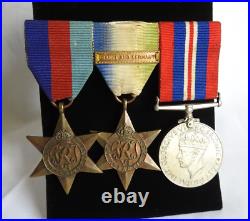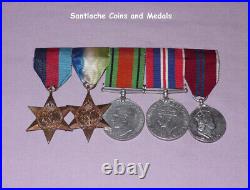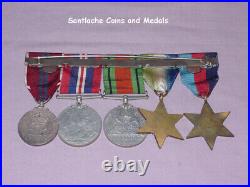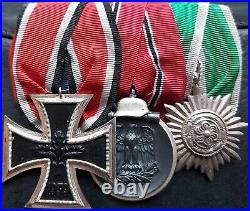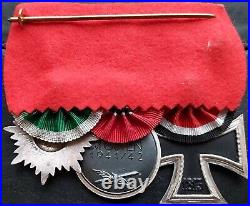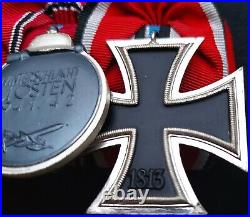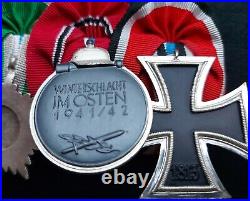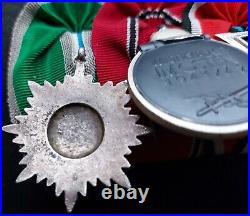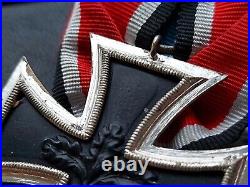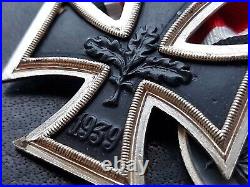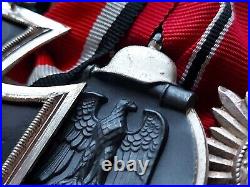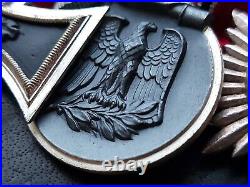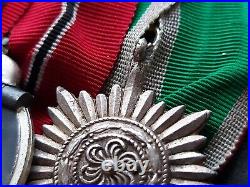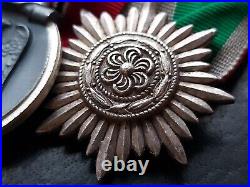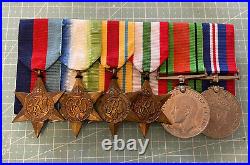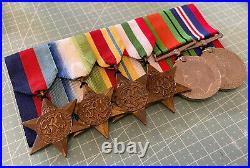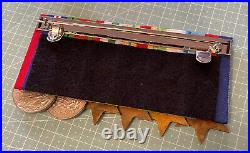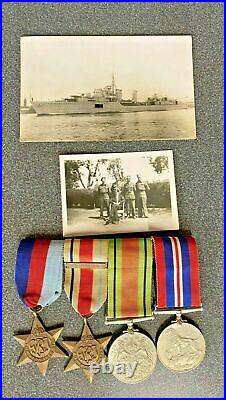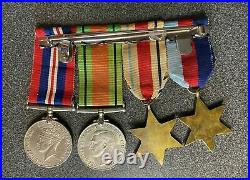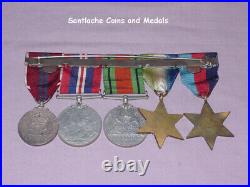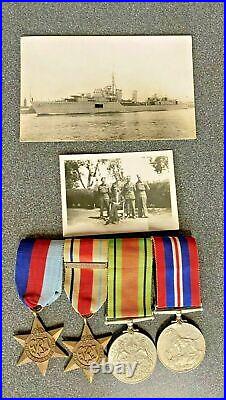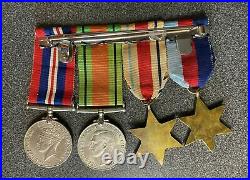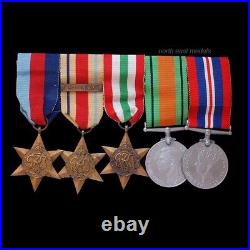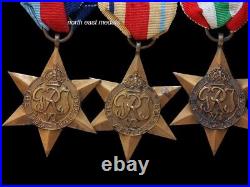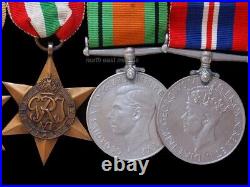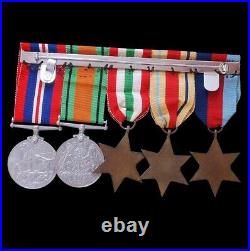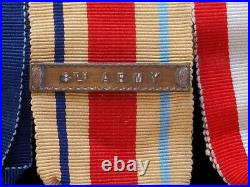Posts tagged mounted
Please view all pictures and read condition report. Please find details of item description below. WW2 Mounted Medals – Group of Three. Guaranteed Genuine Original Items. Medal group consists of. 1939 – 1945 Star. Atlantic Star with France and Germany Bar. 1939 – 1945 War Medal. A fabulous set of WW2 medals with original ribbons and pin bar mounting. On 8 July 1943, the. Star later named the. Star and the Africa Star became the first two campaign stars instituted by the United Kingdom, and by May 1945 a total of eight stars and nine clasps had been established to reward campaign service during the Second World War. The 1935 – 1945 Star – Set of a ribbon of dark blue, red and light blue – if awarded, could also be issued with either the Battle of Britain or the Bomber command clasp. The Battle of Britain, also known as the Air Battle for England, was a military campaign of the Second World War, in which the (RAF) Royal Air Force and the (FAA) Fleet Air Arm of the Royal Navy defended the United Kingdom against large scale attacks by Nazi Germany’s Air force. The Atlantic Star – Set on a ribbon of blue, white and sea green shaded and watered, is a military campaign medal, instituted by the United Kingdom in May 1945 for award to British Commonwealth forces who took part in the Battle of the Atlantic. The Battle of Atlantic was the longest continuous campaign of the Second World War. Two clasps were instituted and could be worn on the medal ribbon, the Air Crew Europe and France and Germany. These are vintage pre-loved and used items in overall. Lovely condition for age of items with some age and use related wear as expected. Please refer to all the detailed photographs for best judge of the overall condition. Please check out our other listing and add our shop to your favourites. Please refer to all the detailed photographs for best judge of the overall condition; As they are an important part of the condition report. Antiques can show some signs of wear consistent with age, use and storage. Antiques are in original vintage condition, other than a gentle wipe. Please note that with any vintage items they may show small traces of wear or glaze crazing or age-related wear. If there are any cracks, chips or damage this will be detailed in the description – and shown in the photographs, so please study the supplied images. We genuinely pride ourselves on our honesty and integrity. We re-use as much packaging as possible. We do have to bubble wrap some of our items, but we keep all bubble wrap for re-use. Your packages will always be securely wrapped and packaged. The things we sell. Shrink wrapped and over packaged, our items are vintage. We like to give them a new home. There is the occasional exception, were we sell. Orders are usually posted daily by 11.30am, orders placed after this time are posted the next day. This is simply because parcels are collected once a day around 12.30 from the depot. On the rare occasion when you want to return an item, our policy is simple.
The group contains the following original medals. 1953 Queen Elizabeth II Coronation Medal. The medals are all unnamed as issued and are in gVF condition or better and come mounted on a pin bar – see photos. The 1953 Coronation Medal is made of. 925 sterling silver which is a genuine and original Royal Mint issue. This item is in the category “Collectables\Militaria\World War II (1939-1945)\Medals/ Ribbons”. The seller is “santlache_sales” and is located in this country: GB. This item can be shipped worldwide.
- Modified Item: No
- Country/Region of Manufacture: United Kingdom
- Country/ Organization: Great Britain
- Issued/ Not-Issued: Issued
- Theme: Militaria
- Featured Refinements: Medal Group
- Type: Medals & Ribbons
- Conflict: World War II (1939-1945)
- Clothing Type: Medals
- Service: British and Commonwealth
- Era: 1914-1945
Original German post WW2 / 1957 pattern mounted medal group: Iron Cross II. Class, Eastern Front Medal & Medal for Gallantry and Merit for Members of the Eastern Peoples in Silver Without Swords II. Class, IN GOOD CONDITION, ON GENUINE RIBBONS, PERFECT PIN DEVICE, MAKER: STEINHAUER & LUECK (ST&L), A REALLY NICE MEDAL GROUPING INDEED. HISTORY OF THE AWARDS. Iron Cross (German: Eisernes Kreuz) was a military decoration of the Kingdom of Prussia, and later of Germany, which was established by King Friedrich Wilhelm III of Prussia and first awarded on 10 March 1813 in Breslau. In addition to during the Napoleonic Wars, the Iron Cross was awarded during the Franco-German War, the First World War, and the Second World War. The Iron Cross was normally a military decoration only, though there were instances of it being awarded to civilians for performing military functions. Two examples, the civilian pilot Hanna Reitsch was awarded the Iron Cross First Class for her bravery as a test pilot during the Second World War and Melitta Schenk Gräfin von Stauffenberg (also a German female test pilot) was awarded the Iron Cross Second Class. The Iron Cross was also used as the symbol of the German Army from 1871 to 1915, when it was replaced by a simpler Greek cross. In 1956, the Iron Cross became the symbol of the Bundeswehr, the German armed forces. The traditional design is black and this design is used on armored vehicles and aircraft. A newer design in blue and silver is used as the emblem in other contexts. The Iron Cross is a black four-pointed cross with white trim, with the arms widening towards the ends, similar to a cross pattée. It was designed by the neoclassical architect Karl Friedrich Schinkel and reflects the cross borne by the Teutonic Knights in the 14th century. The ribbon for the 1813, 1870 and 1914 Iron Cross (2nd Class) was black with two thin white bands, the colours of Prussia. The noncombatant version of this award had the same medal, but the black and white colours on the ribbon were reversed. Initially the Iron Cross was worn with the blank side out. This did not change until 1838 when the sprig facing could be presented. Since the Iron Cross was issued over several different periods of German history, it was annotated with the year indicating the era in which it was issued. For example, an Iron Cross from the First World War bears the year “1914″, while the same decoration from the Second World War is annotated “1939″. The reverse of the 1870, 1914 and 1939 series of Iron Crosses have the year “1813″ appearing on the lower arm, symbolizing the year the award was created. The 1813 decoration also has the initials “FW” for King Frederick William III, while the next two have a “W” for the respective kaisers, Wilhelm I and Wilhelm II. The final version shows a swastika. It was also possible for a holder of the 1914 Iron Cross to be awarded a second or higher grade of the 1939 Iron Cross. In such cases, a “1939 Clasp” (Spange) would be worn on the original 1914 Iron Cross. A similar award was made in 1914 but was quite rare, since there were few in service who held the 1870 Iron Cross. For the First Class award the Spange appears as an eagle with the date “1939″ that was pinned above the Cross. Although two separate awards, in some cases the holders soldered them together. A cross was the symbol of the Teutonic Knights (a heraldic cross pattée), and the cross design (but not the specific decoration) has been the symbol of Germany’s armed forces (now the Bundeswehr) since 1871. The Iron Cross was founded on 10 March 1813 in Breslau and awarded to soldiers during the Wars of Liberation against Napoleon. It was first awarded to Karl August Ferdinand von Borcke on 21 April 1813. King Wilhelm I of Prussia authorized further awards on 19 July 1870, during the Franco-German War. The Iron Cross was reauthorized by Emperor Wilhelm II on 5 August 1914, at the start of the First World War. During these three periods, the Iron Cross was an award of the Kingdom of Prussia, although given Prussia’s pre-eminent place in the German Empire formed in 1871, it tended to be treated as a generic German decoration. The 1813, 1870, and 1914 Iron Crosses had three grades: Iron Cross 2nd Class German: Eisernes Kreuz 2. Klasse, Iron Cross 1st Class German: Eisernes Kreuz 1. Klasse, Grand Cross of the Iron Cross (German: Großkreuz des Eisernen Kreuzes, often simply Großkreuz). Although the medals of each class were identical, the manner in which each was worn differed. Employing a pin or screw posts on the back of the medal, the Iron Cross First Class was worn on the left side of the recipient’s uniform. The Grand Cross and the Iron Cross Second Class were suspended from different ribbons. The Grand Cross was intended for senior generals of the German Army. An even higher decoration, the Star of the Grand Cross of the Iron Cross, was awarded only twice, to Field Marshal Gebhard von Blücher in 1813 and to Field Marshal Paul von Hindenburg in 1918. A third award was planned for the most successful German general during the Second World War, but was not made after the defeat of Germany in 1945. The Iron Cross 1st Class and the Iron Cross 2nd Class were awarded without regard to rank. One had to already possess the 2nd Class in order to receive the 1st Class (though in some cases both could be awarded simultaneously). The egalitarian nature of this award contrasted with those of most other German states (and indeed many other European monarchies), where military decorations were awarded based on the rank of the recipient. For example, Bavarian officers received various grades of that Kingdom’s Military Merit Order (Militär-Verdienstorden), while enlisted men received various grades of the Military Merit Cross (Militär-Verdienstkreuz). Prussia did have other orders and medals which were awarded on the basis of rank, and even though the Iron Cross was intended to be awarded without regard to rank, officers and NCOs were more likely to receive it than junior enlisted soldiers. In the First World War, approximately four million Iron Crosses of the lower grade (2nd Class) were issued, as well as around 145,000 of the higher grade (1st Class). Exact numbers of awards are not known, since the Prussian archives were destroyed during the Second World War. The multitude of awards reduced the status and reputation of the decoration. Among the holders of the 1914 Iron Cross 2nd Class and 1st Class was Adolf Hitler, who held the rank of Gefreiter. Hitler can be seen wearing the award on his left breast, as was standard, in many photographs. The straight-armed Balkenkreuz, the emblem of the Wehrmacht, first used in a narrower form on Luftstreitkräfte aircraft in mid-April 1918, and as shown here, as it appeared on German planes, tanks, and other vehicles during the Second World War. Adolf Hitler restored the Iron Cross in 1939 as a German decoration (rather than Prussian as in earlier versions), continuing the tradition of issuing it in various grades. Legally it is based on the enactment Reichsgesetzblatt I S. 1573 of 1 September 1939 Verordnung über die Erneuerung des Eisernen Kreuzes (Regulation for the Re-introduction of the Iron Cross). The Iron Cross of the Second World War was divided into three main series of decorations with an intermediate category, the Knight’s Cross, instituted between the lowest, the Iron Cross, and the highest, the Grand Cross. The Knight’s Cross replaced the Prussian Pour le Mérite or “Blue Max”. Hitler did not care for the Pour le Mérite, as it was a Prussian order that could be awarded only to officers. The ribbon of the medal (2nd class and Knight’s Cross) was different from the earlier Iron Crosses in that the color red was used in addition to the traditional black and white (black and white were the colours of Prussia, while black, white, and red were the colors of Germany). Hitler also created the War Merit Cross as a replacement for the non-combatant version of the Iron Cross. It also appeared on certain Nazi flags in the upper left corner. The edges were curved, like most original iron crosses. The standard 1939 Iron Cross was issued in the following two grades: Iron Cross 2nd Class Eisernes Kreuz 2. Klasse, Iron Cross 1st Class Eisernes Kreuz 1. Klasse abbreviated as EKI or E. The Iron Cross was awarded for bravery in battle as well as other military contributions in a battlefield environment. The Iron Cross 2nd Class came with a ribbon and was worn in one of two different methods: when in formal dress, the entire cross was worn mounted alone or as part of a medal bar, for everyday wear, only the ribbon was worn from the second hole in the tunic button. The Iron Cross First Class was a pin-on medal with no ribbon and was worn centered on a uniform breast pocket, either on dress uniforms or everyday outfit. It was a progressive award, with the second class having to be earned before the first class and so on for the higher degrees. It is estimated that some four and a half million Second Class Iron Crosses were awarded in the Second World War, and 300,000 of the First Class. The Eastern Front Medal, (Winterschlacht Im Osten), more commonly known as the Ostmedaille was instituted on May 26, 1942 to mark service on the German Eastern Front (World War II) during the period November 15, 1941 to April 15, 1942. It was commissioned to recognise the hardship endured by German and Axis Powers personnel, combatant or non-combatant, during the especially bitter Russian winter of’41/’42. It was wryly called the “Gefrierfleischorden” (Frozen Meat Medal) by the Heer, Luftwaffe & Waffen-SS personnel to whom it was awarded. Qualification for the award: 14 days served in active combat within the specified area between November 15, 1941 – April 15, 1942, 60 days served in specified area between November 15, 1941 – April 15, 1942, non-combat, wounded in action, killed in action (posthumous award) or injury caused by frostbite (or another injury related to the climate) severe enough to warrant the issue of a Wound Badge. Unique in that its designer was a contemporary serving soldier, SS-Unterscharführer Ernst Krause, the medal was held in high regard by all branches of the Wehrmacht. Measuring 36mm in diameter, of (generally) zinc construction, the medal was given a gun-metal coloured coating. On one side an eagle grasps a Swastika and the reverse features the text “Winterschlacht Im Osten 1941/42″ featuring a crossed sword and branch below the text. The helmet and outer ring were finished in a polished silver effect. A ribbon that accompanied the medal was coloured red, white and black (symbolic of blood, snow and death). The medal and ribbon were usually presented in a paper packet, but these were invariably discarded. Over 3 million were made by more than 26 confirmed firms by the time the order was officially decommissioned by Oberkommando der Wehrmacht on September 4, 1944. The medal itself was not worn on the combat tunic as per the 1st class Iron Cross & War Merit Cross for example, but worn as a ribbon bar, or as the ribbon alone stitched through the second from top tunic buttonhole as per 2nd Class Iron Cross and War Merit Cross. Medal for Gallantry and Merit for Members of the Eastern Peoples (Tapferkeits-und Verdienst-Auszeichnung für Angehörige der Ostvölker) – As early as July 1941, Russian POWs were allowed to offer their services to the German Army formations as “Hilfswilliger” (Volunteer helpers or auxiliaries). By the end of 1941 the Wehrmacht employed around 150,000 Hiwis as they were known by the Germans. By 1942 these men were use by the Germans to form military anti-partisan formations known as “Osttruppen” (Eastern Troops). Initially German commanders awarded men from the Osttruppen with German war badges and decorations, but when Hitler learned of this, he put a stop to it. Hitler did not like the idea of having these Russian troops wearing German medals. Something needed to be done to award the Osttruppen. To remedy this, official decorations were created. The so-called Eastern People medal and badge was designed by Elmar Lang and instituted on 14 July 1942. The Eastern People medal and badge were in the shape of a star. The Eastern People decorations were as follows: 2nd Class in bronze, silver and gold, 1st Class in silver and gold. At the beginning these decorations were awarded exclusively to Russians, but eventually German personnel who commanded these troops were allowed to wear such awards, giving these medals a more legitimatize meaning. It should be noted that the Germans had to be wearing the Iron Cross 2nd and 1st class before obtaining the Eastern People silver version award. The case is two piece hinged construction with black simulated leather outer surface. The face of the lid bears an exact facsimile of the badge contained in the case. The facsimile is stenciled in gold for the award in gold. By late 1943, Hitler relented and allowed these Osttruppen to wear German War Badges such as the Infantry, General Assault and Wounded badges along with the Eastern People awards. By 1944, the Osttruppen were granted the right to the Iron Cross 1st and 2nd class. No Russian soldier serving in the German Army ever received the Knight’s Cross to the Iron Cross. On 14 November 1944, the Germans officially recognized the Russian National Army. The Commander in Chief of the new Russian Liberation Army was General Andre A. The men of the Russian Liberation Army received the same Eastern Peoples awards. According to some sources special ribbons were made and issued on 2nd class medals, which are as follows: 2nd Class – bronze: lime green ribbon with light blue center stripe, 2nd Class – silver: grass green ribbon with dark blue center stripe and 2nd Class gold: light yellow ribbon with dark red center stripe. This item is in the category “Collectables\Militaria\World War II (1939-1945)\Medals/ Ribbons”. The seller is “a..anderson” and is located in this country: GB. This item can be shipped worldwide.
- Country/Region of Manufacture: Germany
- Conflict: World War II (1939-1945)
- Service: Army
- Country/ Organization: Germany
- Theme: Militaria
- Featured Refinements: Medal Group
- Era: 1945-Present
- Type: Medals & Ribbons
WW2 ORIGINAL MEDAL GROUP COURT MOUNTED. LOVELY SET OF ORIGINAL MEDALS IN GREAT CONDITION. COURT MOUNTED WITH NEW RIBBONS READY TO WEAR OR FRAME. ANY QUESTION PLEASE DO NOT HESITATE TO ASK. KEEP AND EYE IN MY OTHER MEDAL SALES AND THOSE COMING SOON. This item is in the category “Collectables\Militaria\World War II (1939-1945)\Medals/ Ribbons”. The seller is “almightywhyty031″ and is located in this country: GB. This item can be shipped to United Kingdom, Antigua and Barbuda, Austria, Belgium, Bulgaria, Republic of Croatia, Cyprus, Czech Republic, Denmark, Estonia, Finland, France, Germany, Greece, Hungary, Ireland, Italy, Latvia, Lithuania, Luxembourg, Malta, Netherlands, Poland, Portugal, Romania, Slovakia, Slovenia, Spain, Sweden, Australia, United States, Bahrain, Canada, Japan, New Zealand, China, Israel, Hong Kong, Norway, Indonesia, Malaysia, Mexico, Singapore, South Korea, Switzerland, Taiwan, Bangladesh, Belize, Bermuda, Bolivia, Barbados, Brunei Darussalam, Cayman Islands, Dominica, Egypt, Guernsey, Gibraltar, Guadeloupe, Grenada, French Guiana, Iceland, Jersey, Jordan, Cambodia, Saint Kitts-Nevis, Saint Lucia, Liechtenstein, Sri Lanka, Macau, Monaco, Maldives, Montserrat, Martinique, Nicaragua, Oman, Pakistan, Paraguay, Reunion, Turks and Caicos Islands, Aruba, Saudi Arabia, South Africa, United Arab Emirates, Chile, Bahamas, Colombia, Costa Rica, Dominican Republic, Guatemala, Honduras, Jamaica, Kuwait, Panama, Philippines, Qatar, El Salvador, Trinidad and Tobago.
- Type: Medals & Ribbons
- Issued/ Not-Issued: Issued
- Conflict: World War II (1939-1945)
- Era: 1914-1945
- Country/ Organization: Great Britain
- Theme: Militaria
- Service: Army
- Country/Region of Manufacture: United Kingdom
Four BRITISH MEDALS including an Africa Star with clasp North Africa 1942 1943. Mounted for wear and with two original photographs, both naval. Nice matching patina and ribbons faded from wear/ display. This item is in the category “Collectables\Militaria\World War II (1939-1945)\Medals/ Ribbons”. The seller is “kings-head” and is located in this country: GB. This item can be shipped worldwide.
- Country/Region of Manufacture: United Kingdom
- Country/ Organization: Great Britain
- Theme: Militaria
- Featured Refinements: Medal Group
- Type: Medals & Ribbons
- Conflict: World War II (1939-1945)
- Era: 1914-1945
The group contains the following original medals. 1953 Queen Elizabeth II Coronation Medal. The medals are all unnamed as issued and are in gVF condition or better and come mounted on a pin bar – see photos. The 1953 Coronation Medal is made of. 925 sterling silver which is a genuine and original Royal Mint issue. This item is in the category “Collectables\Militaria\World War II (1939-1945)\Medals/ Ribbons”. The seller is “santlache_sales” and is located in this country: GB. This item can be shipped worldwide.
- Modified Item: No
- Country/Region of Manufacture: United Kingdom
- Country/ Organization: Great Britain
- Issued/ Not-Issued: Issued
- Theme: Militaria
- Featured Refinements: Medal Group
- Type: Medals & Ribbons
- Conflict: World War II (1939-1945)
- Clothing Type: Medals
- Service: British and Commonwealth
- Era: 1914-1945
Four BRITISH MEDALS including an Africa Star with clasp North Africa 1942 1943. Mounted for wear and with two original photographs, both naval. Nice matching patina and ribbons faded from wear/ display. This item is in the category “Collectables\Militaria\World War II (1939-1945)\Medals/ Ribbons”. The seller is “kings-head” and is located in this country: GB. This item can be shipped worldwide.
- Country/Region of Manufacture: United Kingdom
- Country/ Organization: Great Britain
- Theme: Militaria
- Featured Refinements: Medal Group
- Type: Medals & Ribbons
- Conflict: World War II (1939-1945)
- Era: 1914-1945
WW2 Group of 5 Mounted Medals Inc, 8th Army Africa Star, Italy Star. Swing mounted as worn- 1939-45 Star, Africa Star with original 8th Army Bar, Italy Star, Defence Medal, 1939-45 War Medal. Photo is of the item you will receive, we don’t use stock photos. For more original medals and badges. This item is in the category “Collectables\Militaria\World War II (1939-1945)\Medals/ Ribbons”. The seller is “north_east_medals” and is located in this country: GB. This item can be shipped worldwide.
- Issued/ Not-Issued: Issued
- Era: 1914-1945
- Conflict: World War II (1939-1945)
- Country/ Organization: Great Britain
- Service: Army
- Theme: Militaria
- Country/Region of Manufacture: Unknown
- Modified Item: No
